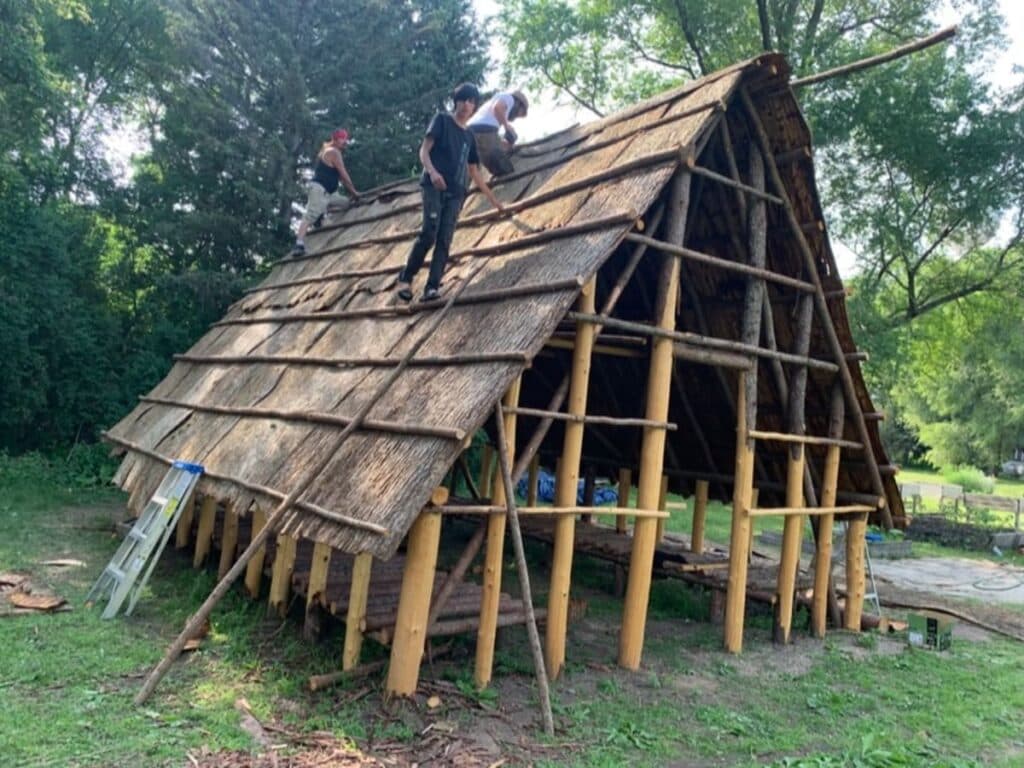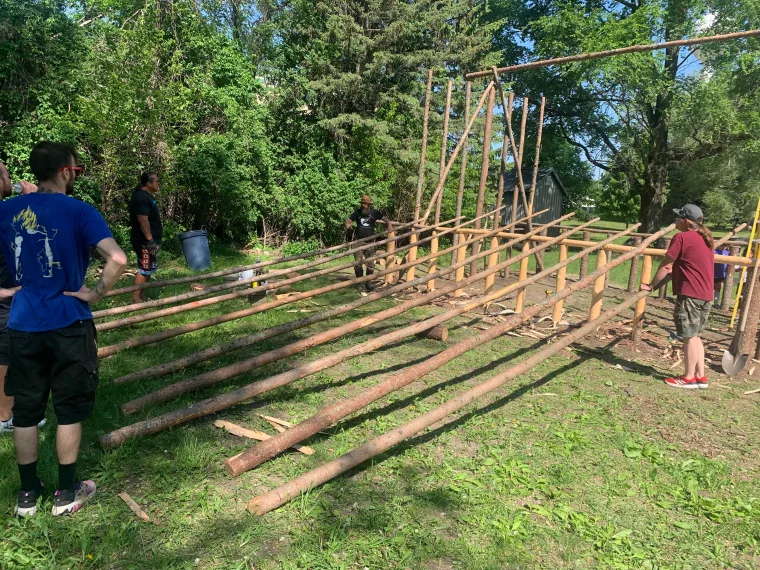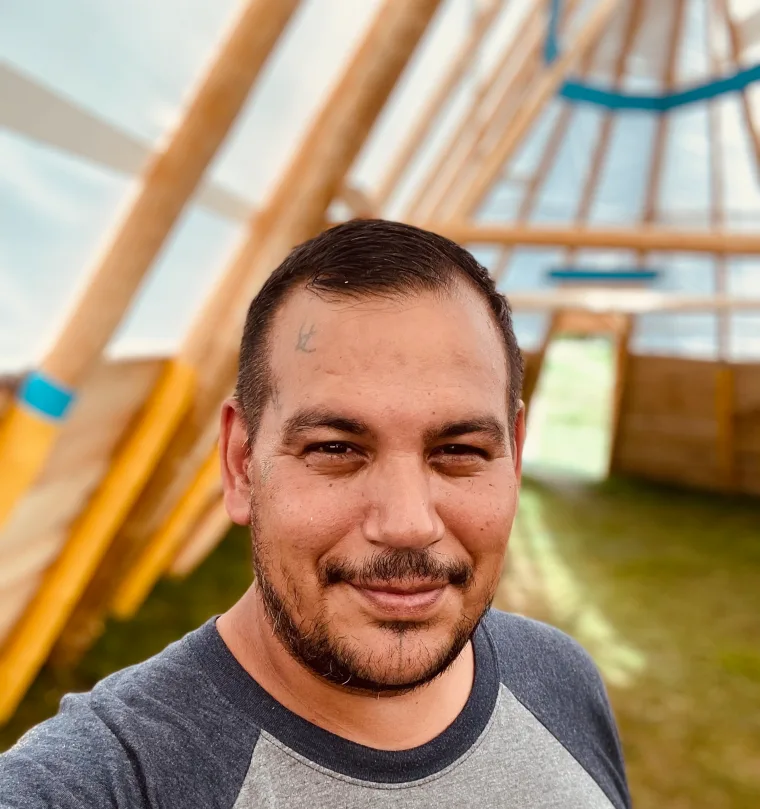Dakota Access Pipeline
Traditional elm bark lodges return to Minnesota
Indigenous communities join forces to build traditional lodges in Minnesota and Ontario
Dan Ninham
ICT

A traditional Dakota elm bark lodge goes up in May and June 2023 at the Lower Sioux Community in Minnesota, one of the first traditional lodges to be built in more than 100 years in the region. Through a partnership with the Great Lakes Lifeways Institute, lodges have been contructed for the Prairie Island Indian and Lower Sioux communities in Minnesota, and one is set to be constructed later in 2023 for the Aamjiwnaang First Nation in Ontario, Canada. (Photo courtesy of Sean Contreras)
The Great Lakes Lifeways Institute is joining forces with Indigenous nations in Minnesota and Ontario to build three elm bark community lodges as part of a growing effort to bring traditional lodges back to the region.
The lodges are among the first traditional lodges built in Minnesota in more than 100 years.
The institute has been working to build the lodges with the Prairie Island Indian and Lower Sioux communities in Minnesota, and the Aamjiwnaang First Nation in Ontario just south of the southern tip of Lake Huron.
“These grassroots projects brought together dozens of people, created powerful collaborative synergy between diverse communities and nations, all to create and reestablish traditional spaces for healing, growth, learning, teaching and even birthing,” said Great Lakes Lifeways founder and executive director Kevin Finney, in a recent Facebook post.
“Bringing these projects to fruition has been the result of over a year of collective planning, envisioning and hard work of all the project partners.”
From building snow snakes to birch bark canoes, the Michigan-based nonprofit organization has been working with and supporting efforts to sustain and revive traditional ways.
The first elm bark lodge to go up was on the Prairie Island Indian Community in Minnesota near the Mississippi River in 2022, followed by construction in May and June this year of another lodge at Prairie Island and one at the Lower Sioux Community, which is also in Minnesota.
Construction of a lodge for the Aamjiwnaang First Nation in Ontario is scheduled for later this year.

Prairie Island President Johnny Johnson told Minnesota Public Radio that the lodge is important for his community.
“It’s proven now in today’s society of the way of life and for the survival of the Mdewakantons back in those days,” he said. “We look forward to many gatherings at the lodge for our youth and elders and talking about how and what has happened in these lodges in those days. And so we’re very excited about the first lodge being built here.”
Great Lakes Lifeways Institute, which was founded in 2009 by Kinney, who is of Finnish descent, works to engage communities to “elevate skills, knowledge and network resources to decolonize and revitalize traditional ways of being,” according to the website.
The organization responds to grassroots needs and travels to dozens of communities around the Great Lakes and Canada. It has worked to build traditional cultural spaces such as lodges, reconnect people with traditional waterways through ancestral watercrafts, provided guidance on treaty rights for seasonal harvest, created sustainable systems around traditional food ways, and brought elders and youths together to share intergenerational knowledge.
“Our team chooses to support projects which are rarely done anywhere else and often those which embrace breathing life back into practices which have not been implemented in many generations,” according to the website.
Collecting the elm bark
Because elm trees have been hit by disease in Minnesota, the construction required travel to Indiana to collect the elm bark necessary for the traditional lodges.
“We had two large teams representing multiple tribal nations and community organizations spend around two weeks in Northern Indiana to harvest the American elm bark used to cover the lodges,” Finney said in the Facebook post. “In order to do this sustainably, ethically and responsibly, we collaborate with hardwood logging operations to locate, select, GPS and mark trees which are already slated to be harvested for lumber or firewood.”
The coordination allowed the bark — which would normally be destroyed — to be used by Dakota and Anishinaabe communities for traditional cultural purposes. To ensure the long-term sustainability of the practices, the institute is working on a plan for elm restoration and planting programs in partnership with multiple tribal nations, Finney said.
The bark had to be kept wet until it arrived in Minnesota for the construction or it would not have been malleable enough to complete the lodge.
“I can’t express enough how deeply proud I am of all the tremendous hard work that has taken place to make this happen from the leadership/administrative levels of planning to the countless hands from all generations who dedicated their time, travel, effort and care to multiple weeks of detailed and sometimes physically exhausting work that was required,” Finney said.
Helping hands
Sean Contreras, who represents Nis’to Inc. a Native youth nonprofit on the Lake Traverse Reservation, took a youth group to help with the recent Prairie Island and Lower Sioux projects.
“I was able to bring Dakota youth to help in the construction of the bark lodge frame and bark covering,” said Contreras, who is Wahpekute Dakota from the Sisseton-Wahpeton Oyate and lives in the Enemy Swim District of the Lake Traverse Reservation in northeastern South Dakota.
He said the bark lodge is important in Dakota culture.
“The bark lodge is a Dakota cultural dwelling that was utilized along with the earth lodge and the tipi as needed for gatherings, food preservation and ceremonial use,” Contreras told ICT in an email. “Nis’to is also constructing a bark lodge this year for their bundle carrier’s camp. The bark lodge is another cultural structure that is coming back to the Dakota people. It has been well over a century since us Dakota have built lodges and it is an honor to be a part of these builds in an effort to being these spaces back for our people.”
Contreras said he had the opportunity to be invited to the bark lodge construction in Prairie Island and Lower Sioux communities.
“I was able to bring several Dakota youth with me to help in the construction of the bark lodges,” he said. “Most of them didn’t have previous construction experience but picked up very quickly on the work and were a great help. The Prairie Island and Lower Sioux communities were also great hosts to us during the construction.”
Another helper on the projects was Kaesha Maliha Baloch, who is of the Indigenous people of Balochistan, which is split between the Pakistani province of Balochistan and Iranian Baluchestan. She resides in Minneapolis, and was part of the bark lodge building crew. She is also on the team of the Great Lakes Lifeways Institute.
“I touched every part of the build, including the pre- and post-planning for the bark house builds,” Baloch told ICT. “From offering tobacco, and following my dream state, to navigating the various logistical obstacles that arose, I put in blood, sweat, and labor of love.”
Working with the youths was a highlight of the construction, she said.
“My favorite role was stepping back and allotting our youth to take ownership over the various roles in harvesting the American elm bark by building the tamarack tree frame to attaching the roofing and siding,” Baloch said. “I loved stepping back and watching our relatives gain confidence and comfort with the collaborative effort.”
Traditional ways
Other indigenous communities are also building lodges for their own purposes and continuing the Indigenous thought and practice of the ways of knowing, doing, and being with them, including a separate project in Ontario.
“Boozhoo kina wiya,” said Isaac Murdoch, who worked on construction of a lodge in Ontario. “Hello, everyone.”
Murdoch, who is from the Fish Clan of the Serpent River First Nation in Ontario and lives in Nimkii Aazhibikoong, said the construction was done carefully according to tradition. It is not made of elm bark but resembles a teepee.

“We built a lodge that is 62 feet long and 25 feet wide,” Murdoch told ICT. “It is also 23 feet high. It is called a ‘Zhaabandowaan‘ meaning there are doors on both ends of the lodge and you can walk through it.”
Special blessings started the process, he said.
“The work required to build such a lodge is first laying tobacco and asking for this lodge to come to live with us and take care of us,” Murdoch said. “Once special blessings are sent, we begin to harvest the black spruce poles. They weigh about 200-300 pounds each. Once they are harvested with grace, the logs are peeled and stored above ground on logs. This is to prevent the molding of the logs.”
Workers then marked out the perimeter of the lodge and the exact location for each pole, he said.
“Based on our marking on the ground, we will dig each pole in about a foot to stabilize the pole as it’s being erected,” he said. “This prevents the poles from sliding. It takes several people to help do this.”
Once the frame is completed, pine boards are secured to the bottom to about five feet off the group.
“This insulated the bottom of the lodge during winter and also prevents the lodge from caving in from high snow that may have developed over the winter,” he said.
Then a support frame is added inside the lodge to secure it during storms and high winds, and materials are put over the lodge to make it waterproof.
“Stones are then placed in a circle for a fire in the center of the lodge and a hole is open at the top of the lodge to allow the smoke to exit,” he said.
Murdoch grew up with traditional ways of hunting, fishing and trapping, learning from elders in the northern regions of Alberta, Saskatchewan and Manitoba. He is a storyteller and traditional knowledge holder who has committed his life to the preservation of Anishinaabe cultural practices.
“As I was growing up, I had seen these lodges used at hunting camps, sacred sites, and places of ceremony,” he said. “My father and friends would make these lodges for various reasons. Lodges like this or similar to it have been made since our creation story. There is a spirit that lives in these lodges. We respect the life inside.”
He knows personally that the lodges can provide protection, both physically and spiritually.
“One time, we were staying in a zhaabandowaan lodge during a ceremonial camp isolated in the forest,” he said. “We could hear the loud screams of an unknown creature or spirit outside the lodge. It was breaking trees and yelling loud. We stayed inside and prayed. The elder told us we would be safe in the lodge and that the monster could not enter the lodge. The large being left us in peace after about five minutes of yelling and throwing things around. The lodge protected us.”
The new lodge will now be used for ceremonies and teachings for young people and the community.
“It was a community effort to construct and will provide Indigenous youth a language nest and learning space for decades,” he said.
External
After some reworking, law enforcement backs newest alert system
"Our people are worth it": NCAI panel confronts epidemic of violence, long road ahead and need for unity
Reporting Excellence
Tribal elders enjoy an afternoon of games, prizes and food on the Fort Berthold Reservation
Carmen O’Leary fights to help Indigenous survivors of violence amid budget cuts






